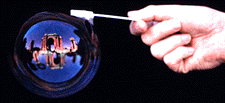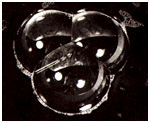When Bubble
Meets Bubble
|

|

|
W
hen one bubble meets with another, the resulting union is always one of total sharing and compromise (Human beings could learn a lot from bubbles.) Since bubbles always try to minimize surface area two bubbles will merge to share a common wall. If the bubbles are the same size as the bubbles to the left, this wall will be flat. If the bubbles are different sized, the smaller bubble, which always has a higher internal pressure, will bulge into the larger bubble.
|
|
R
egardless of their relative sizes, the bubbles will meet the common wall at an angle of 120 degrees. This is easy to see in the bubble picture to the right. All three bubbles meet at the center at an angle of 120 degrees. Although the mathematics to prove this are beyond the scope of this article, the 120 degree rule always holds, even with complex bubble collections like a foam.
|

|

|
I
f you take two sheets of clear glass or plastic separated by about one-half inch, soak them in soapy solution and then blow bubbles between the sheets, you will get many bubble walls. If you look closely, you will notice that all of the vertices where three bubble walls meet (and there are always three,) form 120 degree angles. If your bubbles are of uniform size, you will notice that the cells form hexagons and start to look much like the cells of a beehive. Bees, like bubbles, try to be as efficient as possible when making the comb. They want to use the minimum possible amount of wax to get the job done. Hexagonal cells are the ticket.
|
|